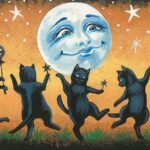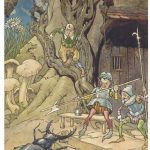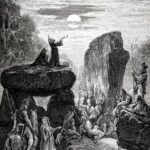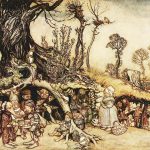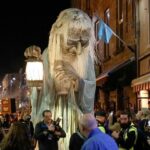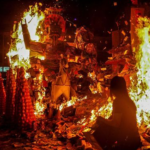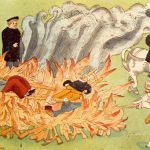Also know as: ShadowFest, Martinmas, Old Hallowmass.
Samhain, All Hallowtide, the feast of the dead in Pagan and Christian times, signaled the close of harvest and the initiation of the winter season, lasting till May, during which troops were quartered. Fairies were imagined as particularly active at this season. From it, the half-year is reckoned. From the “Irish-English Dictionary” published by the Irish Texts Society
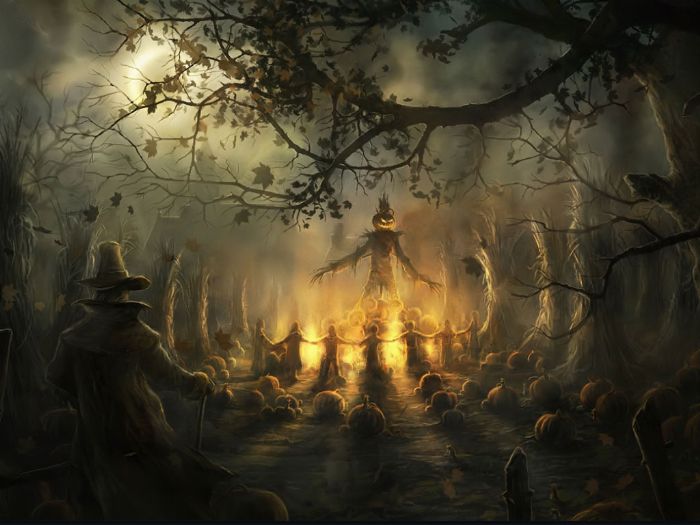
Etymology of Samhain
There are two main hypothesis regarding the etymology for Samhain.
The Old Irish samain, samuin, samfuin, refers to 1 November (lathe na samna, “samhain day”). Its meaning is glossed as “summer’s end”, and the frequent spelling with f suggests analysis by popular etymology as sam “summer” and fuin “sunset, end”. Old Irish sam, c saminos derived from *samo- “summer”. Its cognates are Welsh haf, Breton hañv, Old Norse language sumar all meaning “summer”, and Sanskrit sáma “season”.
Confusingly, Gaulish Samonios (October/November lunation) corresponds to GIAMONIOS, the seventh month (the April/May lunation) and the beginning of the summer season.
In medieval Ireland, samain (oenaig na samna, “samhain night”) was also the name of the principal festival, celebrated with a great assembly at the royal court in Tara.
W. Stokes in KZ 40:245 (1907) suggests an etymology from Proto-Celtic *samani with a meaning “assembly”, cognate to Sanskrit sámana, Gothic samana . J. Vendryes in Lexique Étymologique de l’Irlandais Ancien (1959) concludes that these words containing *semo- “summer” are unrelated to samain, remarking that furthermore the Celtic “end of summer” was in July, not November, as evidenced by Welsh gorffennaf “July”.
Eliade’s “Encyclopedia of Religion” states as follows:
The Eve and day of Samhain were characterized as a time when the barriers between the human and supernatural worlds were broken… Not a festival honoring any particular Celtic deity, Samhain acknowledged the entire spectrum of nonhuman forces that roamed the earth during that period.
A Celtic festival
The Celts, a tribal people who inhabited most of Western and Central Europe in the first millennium BC, were a pastoral people as opposed to an agricultural people. The end of summer was significant to them because it meant the time of year when the structure of their lives changed radically. The cattle were brought down from the summer pastures in the hills and the people were gathered into the houses for the long winter. Samhain began at sundown on October 31 and extended into the following day. On the night that ended summer and began winter, the laws of space and time were suspended, the division between the two worlds became very thin, allowing hostile supernatural forces, ghosts and spirits to wander freely.
The exact customs observed in each Celtic region differ, but they generally involved the lighting of bonfires and the reinforcement of boundaries, across which malicious spirits might cross and threaten the community.
Bonfires played a large part in the festivities celebrated down through the last several centuries. Villagers were said to have cast the bones of the slaughtered cattle upon the flames, cattle having a prominent place in the pre-Christian Gaelic world. Victorian sources claimed the English word ‘bonfire’ derives from these “bone fires” but the Gaelic has no such parallel. With the bonfire ablaze, the villagers extinguished all other fires. Each family then solemnly lit its hearth from the common flame, thus bonding the families of the village together.
To quote
On this night, of all nights, our ancestors believed that the souls of the dead could return and the Little People could come through the doorway. The Little People could be…unpredictable. Among their number were those who cared for human beings, married them, dealt fairly with them. But there were equally as many who might try to kill humans, steal their children and replace them with changeling babies, or trick them into the world of the Sidhe, in which time did not pass the same way it passes on earth. A human tricked into the world of the Sidhe might believe the he had been among them for three days, only to return to earth to discover that 300 years had passed and everyone he was was long dead. ‘The Story We Carry in our Bones’ (2015) by Osborne-McKnight
Since the fairies were abroad on this night, an offering of food or milk was frequently left for them on the steps of the house, so the homeowner could gain the blessings of the “good folk” for the coming year. Many of the households would also leave out a “dumb supper” for the spirits of the departed.
Certainly tell tales of the human sacrifices of the Celts, but Nora Chadwick points out in her book “The Celts” that “it is not without interest that the Romans themselves had abolished human sacrifices not long before Caesar’s time, and references to the practice among various barbarian peoples have certain overtones of self-righteousness. There is little direct archaeological evidence relevant to Celtic sacrifice.”
Indeed, there is little reference to this practice in Celtic literature either. The Fomorians, a race of evil giants said to inhabit portions of Ireland before the coming of the Tuatha de Danaan, or “people of the Goddess Danu”,demanded the sacrifice of 2/3 of the corn, milk, and first born children of the Fir Bolg, or human inhabitants of Ireland. The De Danaan ended this practice in the second battle of Moy Tura, which took place at the same date.
The Samhain celebrations may have survived in several guises as a festival dedicated to the dead. In Ireland and Scotland, the Féile na Marbh, the “festival of the dead” took place on Samhain.
More on fairies
Samhain was also believed to be the time when witches gathered for Sabbat and meeting with the Devil.
Today
Samhain Eve, in Irish and Scots Gaelic, Oidhche Shamhna, is one of the principal festivals of the Celtic calendar, and is thought to fall on or around the 31st of October. It represents the final harvest. In modern Ireland and Scotland, the name by which Halloween is known in the Gaelic language is still “Oíche/Oidhche Shamhna”.
In parts of western Brittany, Samhain is still heralded by the baking of kornigou, cakes baked in the shape of antlers to commemorate the god of winter shedding his “cuckold” horns as he returns to his kingdom in the Otherworld.
Samhain is one of the eight annual holidays referred to as Sabbats observed by modern day pagans, particularly adherents of Wicca. Its date is not universally agreed upon, as Wicca and other neopagan movements have no binding structure upon which all agree. It is most often observed on October 31 and/or November 1 in the Northern Hemisphere.
According to Garderian, Alexandrian, and other traditional lore, Samhain is a time when the Veil that separates the world of the living and the world of the dead becomes thinner, allowing spirits and other supernatural entities to pass between the worlds to socialize with humans. It is also the time of the year when Ancestors and other departed souls are honored and entreated for luck and prosperity.

